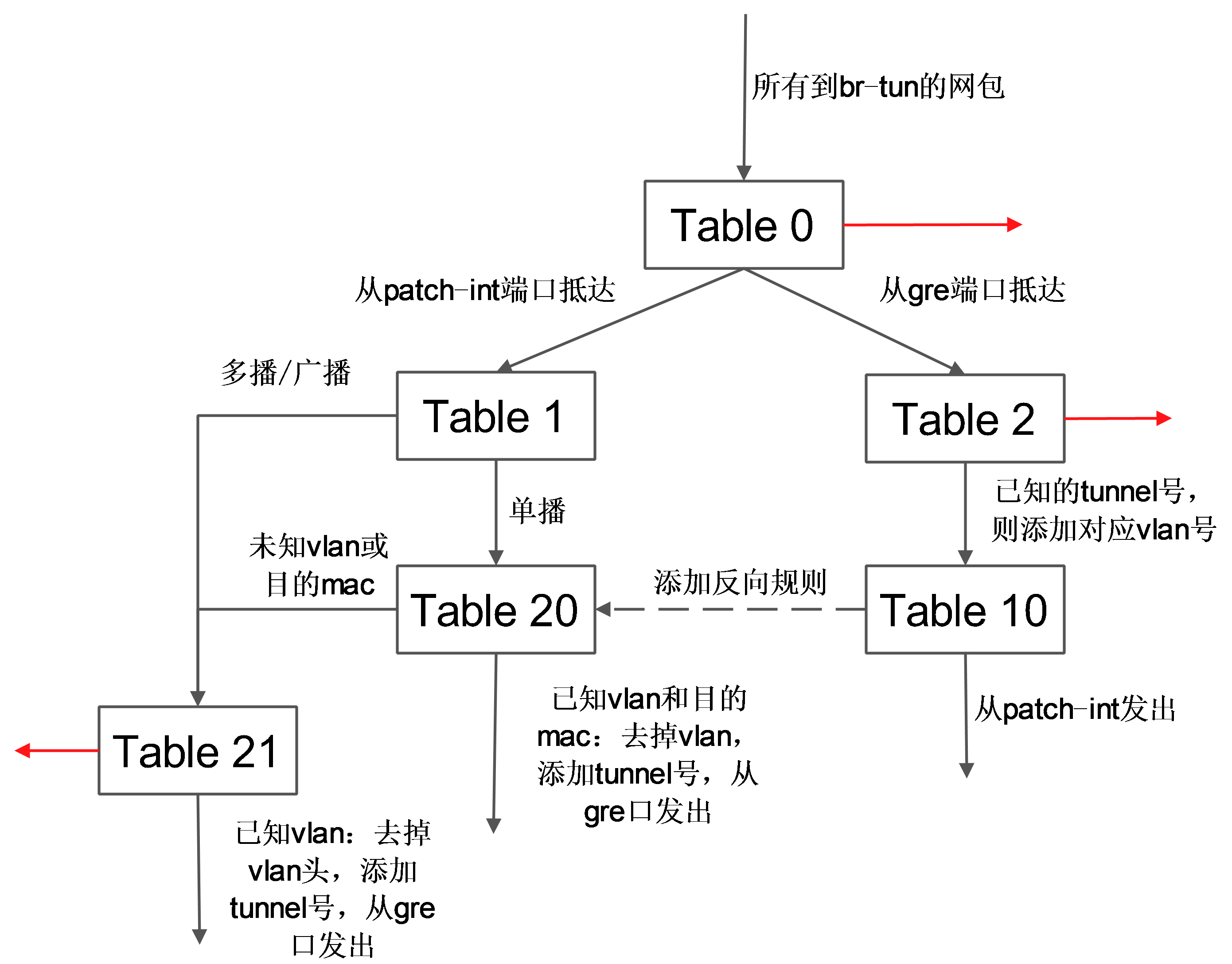计算节点
以抽象系统架构的图表为例,Compute 节点上包括两台虚拟机 VM1 和 VM2,分别经过一个网桥(如 qbr-XXX)连接到 br-int 网桥上。br-int 网桥再经过 br-tun 网桥(物理网络是 GRE 实现)连接到物理主机外部网络。
对于物理网络通过 vlan 来隔离的情况,则一般会存在一个 br-eth 网桥,替代 br-tun 网桥。
qbr
在 VM1 中,虚拟机的网卡实际上连接到了物理机的一个 TAP 设备(即 A,常见名称如 tap-XXX)上,A 则进一步通过VETH pair(A-B)连接到网桥 qbr-XXX 的端口 vnet0(端口 B)上,之后再通过 VETH pair(C-D)连到br-int网桥上。一般C的名字格式为 qvb-XXX,而 D 的名字格式为 qvo-XXX。注意它们的名称除了前缀外,后面的 id 都是一样的,表示位于同一个虚拟机网络到物理机网络的连接上。
之所以 TAP 设备 A 没有直接连接到网桥br-int上,是因为 OpenStack 需要通过 iptables 实现 security group 的安全策略功能。目前 openvswitch 并不支持应用 iptables 规则的 Tap 设备。
因为 qbr 的存在主要是为了辅助 iptables 来实现 security group功能,有时候也被称为安全网桥。详见 security group 部分的分析。
br-int
一个典型的 br-int 的端口如下所示:
# ovs-vsctl show
Bridge br-int
Port "qvo-XXX"
tag: 1
Interface "qvo-XXX"
Port patch-tun
Interface patch-tun
type: patch
options: {peer=patch-int}
Port br-int
Interface br-int
type: internal
其中,
- br-int 为内部端口。
- patch-tun(即端口E,端口号为1)连接到 br-tun 上,实现到外部网络的隧道。
- qvo-XXX(即端口D,端口号为2)带有 tag1,说明这个口是一个1号 vlan 的 access 端口。虚拟机发出的从该端口到达br-int的网包将被自动带上vlan tag 1,而其他带有 vlan tag 1 的网包则可以在去掉 vlan tag 后从该端口发出(即 vlan access 端口)。这个 vlan tag 是用来实现不同网络相互隔离的,比如租户创建一个网络(neutron net-create),则会被分配一个唯一的 vlan tag。
br-int 在 GRE 模式中作为一个 NORMAL 交换机使用,因此有效规则只有一条正常转发。如果两个在同一主机上的 vm 属于同一个 tenant 的(同一个 vlan tag),则它们之间的通信只需要经过 br-int 即可。
# ovs-ofctl dump-flows br-int
NXST_FLOW reply (xid=0x4):
cookie=0x0, duration=10727.864s, table=0, n_packets=198, n_bytes=17288, idle_age=13, priority=1 actions=NORMAL
br-tun
一个典型的 br-tun 上的端口类似:
Bridge br-tun
Port patch-int
Interface patch-int
type: patch
options: {peer=patch-tun}
Port "gre-1"
Interface "gre-1"
type: gre
options: {in_key=flow, local_ip="10.0.0.101", out_key=flow, remote_ip="10.0.0.100"}
Port br-tun
Interface br-tun
type: internal
其中,
- patch-int(即端口 F,端口号为1)是连接到 br-int 上的 veth pair 的端口
- gre-1 端口(即端口 G,端口号为2)对应vm到外面的隧道。gre-1 端口是虚拟 gre 端口,当网包发送到这个端口的时候,会经过内核封包,然后从 10.0.0.101 发送到 10.0.0.100,即从本地的物理网卡(10.0.0.101)发出。
br-tun将带有 vlan tag 的 vm 跟外部通信的流量转换到对应的 gre 隧道,这上面要实现主要的转换逻辑,规则要复杂,一般通过多张表来实现。
典型的转发规则为:
# ovs-ofctl dump-flows br-tun
NXST_FLOW reply (xid=0x4):
cookie=0x0, duration=10970.064s, table=0, n_packets=189, n_bytes=16232, idle_age=16, priority=1,in_port=1 actions=resubmit(,1)
cookie=0x0, duration=10906.954s, table=0, n_packets=29, n_bytes=5736, idle_age=16, priority=1,in_port=2 actions=resubmit(,2)
cookie=0x0, duration=10969.922s, table=0, n_packets=3, n_bytes=230, idle_age=10962, priority=0 actions=drop
cookie=0x0, duration=10969.777s, table=1, n_packets=26, n_bytes=5266, idle_age=16, priority=0,dl_dst=00:00:00:00:00:00/01:00:00:00:00:00 actions=resubmit(,20)
cookie=0x0, duration=10969.631s, table=1, n_packets=163, n_bytes=10966, idle_age=21, priority=0,dl_dst=01:00:00:00:00:00/01:00:00:00:00:00 actions=resubmit(,21)
cookie=0x0, duration=688.456s, table=2, n_packets=29, n_bytes=5736, idle_age=16, priority=1,tun_id=0x1 actions=mod_vlan_vid:1,resubmit(,10)
cookie=0x0, duration=10969.488s, table=2, n_packets=0, n_bytes=0, idle_age=10969, priority=0 actions=drop
cookie=0x0, duration=10969.343s, table=3, n_packets=0, n_bytes=0, idle_age=10969, priority=0 actions=drop
cookie=0x0, duration=10969.2s, table=10, n_packets=29, n_bytes=5736, idle_age=16, priority=1 actions=learn(table=20,hard_timeout=300,priority=1,NXM_OF_VLAN_TCI[0..11],NXM_OF_ETH_DST[]=NXM_OF_ETH_SRC[],load:0->NXM_OF_VLAN_TCI[],load:NXM_NX_TUN_ID[]->NXM_NX_TUN_ID[],output:NXM_OF_IN_PORT[]),output:1
cookie=0x0, duration=682.603s, table=20, n_packets=26, n_bytes=5266, hard_timeout=300, idle_age=16, hard_age=16, priority=1,vlan_tci=0x0001/0x0fff,dl_dst=fa:16:3e:32:0d:db actions=load:0->NXM_OF_VLAN_TCI[],load:0x1->NXM_NX_TUN_ID[],output:2
cookie=0x0, duration=10969.057s, table=20, n_packets=0, n_bytes=0, idle_age=10969, priority=0 actions=resubmit(,21)
cookie=0x0, duration=688.6s, table=21, n_packets=161, n_bytes=10818, idle_age=21, priority=1,dl_vlan=1 actions=strip_vlan,set_tunnel:0x1,output:2
cookie=0x0, duration=10968.912s, table=21, n_packets=2, n_bytes=148, idle_age=689, priority=0 actions=drop
表 0
其中,表 0 中有 3 条规则:从内部端口 1(即patch-int)来的,扔到表 1,从外部端口2(即 gre-1)来的,扔到表2。
cookie=0x0, duration=10970.064s, table=0, n_packets=189, n_bytes=16232, idle_age=16, priority=1,in_port=1 actions=resubmit(,1)
cookie=0x0, duration=10906.954s, table=0, n_packets=29, n_bytes=5736, idle_age=16, priority=1,in_port=2 actions=resubmit(,2)
cookie=0x0, duration=10969.922s, table=0, n_packets=3, n_bytes=230, idle_age=10962, priority=0 actions=drop
表 1
表 1 处理内部过来的网包,有 2 条规则:如果是单播(00:00:00:00:00:00/01:00:00:00:00:00),则扔到表 20;如果是多播等(01:00:00:00:00:00/01:00:00:00:00:00),则扔到表 21。
cookie=0x0, duration=10969.777s, table=1, n_packets=26, n_bytes=5266, idle_age=16, priority=0,dl_dst=00:00:00:00:00:00/01:00:00:00:00:00 actions=resubmit(,20)
cookie=0x0, duration=10969.631s, table=1, n_packets=163, n_bytes=10966, idle_age=21, priority=0,dl_dst=01:00:00:00:00:00/01:00:00:00:00:00 actions=resubmit(,21)
表 2
表 2 处理外部过来的包。有 2 条规则:如果是 tunnel 1(合法的 tunnel id)的网包,则修改其 vlan id 为1,并扔到表 10 学习记录来源;非 tunnel 1(非法的 tunnel id)的网包,则丢弃。
cookie=0x0, duration=688.456s, table=2, n_packets=29, n_bytes=5736, idle_age=16, priority=1,tun_id=0x1 actions=mod_vlan_vid:1,resubmit(,10)
cookie=0x0, duration=10969.488s, table=2, n_packets=0, n_bytes=0, idle_age=10969, priority=0 actions=drop
表 3
表 3 只有 1 条规则:丢弃。
表 10
表 10 负责学习。有一条规则,基于 learn 行动来创建反向(内部网包从 gre 端口发出去)的规则。learn 行动并非标准的 openflow 行动,是 openvswitch 自身的扩展行动,这个行动可以根据流内容动态来修改流表内容。
这条规则首先创建了一条新的流(该流对应 vm 从 br-tun 的 gre 端口发出的规则):其中 table=20 表示规则添加在表 20;NXM_OF_VLAN_TCI[0..11] 表示匹配包自带的v lan id;NXM_OF_ETH_DST[]=NXM_OF_ETH_SRC[] 表示 L2 目标地址需要匹配当前包的 L2 源地址;load:0->NXM_OF_VLAN_TCI[],去掉vlan,load:NXM_NX_TUN_ID[]->NXM_NX_TUN_ID[],添加 tunnel 号为原始 tunnel 号;output:NXM_OF_IN_PORT[],发出端口为原始包抵达的端口。
向表 20 添加完规则后,最后将匹配的当前网包从端口 1(即 patch-int)发出。
cookie=0x0, duration=10969.2s, table=10, n_packets=29, n_bytes=5736, idle_age=16, priority=1 actions=learn(table=20,hard_timeout=300,priority=1,NXM_OF_VLAN_TCI[0..11],NXM_OF_ETH_DST[]=NXM_OF_ETH_SRC[],load:0->NXM_OF_VLAN_TCI[],load:NXM_NX_TUN_ID[]->NXM_NX_TUN_ID[],output:NXM_OF_IN_PORT[]),output:1
表 20
表 20 中有两条规则,其中第一条即表 10 中规则利用 learn 行动创建的内部向外部发包的流表项,第 2 条提交其他流到表 21。
cookie=0x0, duration=682.603s, table=20, n_packets=26, n_bytes=5266, hard_timeout=300, idle_age=16, hard_age=16, priority=1,vlan_tci=0x0001/0x0fff,dl_dst=fa:16:3e:32:0d:db actions=load:0->NXM_OF_VLAN_TCI[],load:0x1->NXM_NX_TUN_ID[],output:2
cookie=0x0, duration=10969.057s, table=20, n_packets=0, n_bytes=0, idle_age=10969, priority=0 actions=resubmit(,21)
表21有2条规则,第一条是匹配所有目标vlan为1的网包,去掉vlan,然后从端口2(gre 端口)发出。第二条是丢弃。
cookie=0x0, duration=688.6s, table=21, n_packets=161, n_bytes=10818, idle_age=21, priority=1,dl_vlan=1 actions=strip_vlan,set_tunnel:0x1,output:2
cookie=0x0, duration=10968.912s, table=21, n_packets=2, n_bytes=148, idle_age=689, priority=0 actions=drop
这些规则所组成的整体转发逻辑如下图所示。
